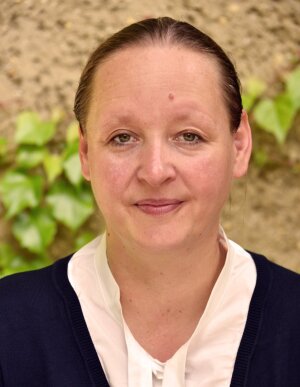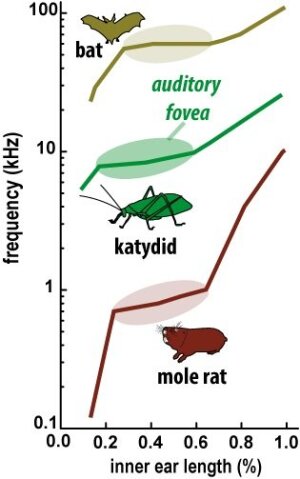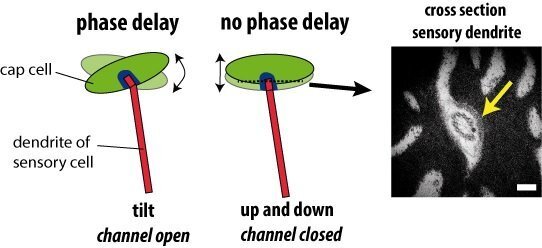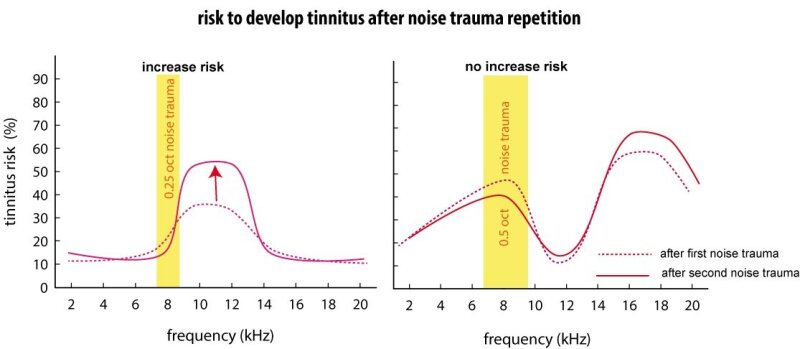Prof. Dr. Manuela Nowotny
Prof. Dr. M. Nowotny
Image: Anne Günther (University of Jena)
Contact
Prof. Dr. Manuela Nowotny
Institute for Zoology and Evolutionary Research
Erbertstrasse 1 (room 110)
07743 Jena
Germany
+49 3641 949 101
manuela.nowotny@uni-jena.de
Research Interest
Sensory Adaptations in the Animal Kingdom
Sensory organs enable us to discriminate environmental signals. It fascinates me how sensory organs can be highly specialized and detect only a small range of the environmental signals but still ensure the survival of the animal. The study of these adaptations enables us to gain knowledge about the perception in general and the regulation of behaviour in particular. My working group investigates functions and adaptations of insect and mammalian ears. Especially, my work with insects provides the potential for the study of natural diversity of mating behaviour and sensory adaptation.
diagramm kHz -> inner ear length (%)
Image: Prof. Dr. Manuela NowotnyEvolution often leads to similar solutions - convergent evolution in hearing
To occupy different niches in an ecosystem, insects developed many different strategies to generate and percept acoustic signals. Recently, we discovered a tropical bushcricket that exhibits a sex-specific adaptation in their communication and ears (Scherberich et al., Current Biology 2016, see figure left). Unique in the animal kingdom, male bushcrickets of the species Ancylecha fenestrata have significant more sensory cells than females of the same species. Surprisingly, these additional cells in the male ears are used to over represent the area where the female call frequency is perceived. This phenomena of an auditory fovea was described so far only as an adaptation of pray (bats) and predator detection (mull) in mammals.
difference between phase delay and no phase delay in sensory dendrite
Image: Prof. Dr. M. NowotnyProcessing of sensory information in the ear
Ears not simply detect environmental signals and translate these into a neuronal correlate. By the processing in the ear, signals important for the animal are amplified or filtered. I started my studies in hearing by the investigation of these amplification processes in the mammalian ear and discovered a mechanism of direct fluid coupling between outer and inner hair cells (Nowotny and Gummer, PNAS 2006). In my group we continue this type of studies in insects and revealed a biomechanical filter mechanisms, which are important for the channel gating (Hummel et al. J. Neurosci, 2016, see figure below). One other surprising finding was that bushcrickets use travelling waves for frequency discrimination (Palghat Udayashankar et al. 2012 and 2015, see movies). These waves are comparable (wave propagation velocity and wave length) to travelling waves found in mammals.
Funding:
The project is funded by the Deutsche Forschungsgemeinschaft (NO 841/1-1 and NO 841/2-1). Additional funding was provided by the Jürgen Manchot foundation and Goethe University by the project "Nachwuchswissenschaftler/innen im Fokus"
Inner Ear Damages and the Generation of Tinnitus
The emergence of tinnitus after acoustic overstimulation and damage to the inner ear is an enormous psychological burden for patients. Exact causes of the resulting phantom noise are largely unknown. We suspect one reason for the initiation of the development of tinnitus in the signal transduction process and routing in the inner ear. Our experiments include the examination of the shift from acute to chronic tinnitus after acoustic overstimulation by using the startle reflex response in gerbils, rats and mice. We explore for example the question how noise-induced hearing loss and plasticity related changes in the brain shape tinnitus characteristics and found that the perceived frequency of tinnitus depends on the bandwidth of the applied noise trauma and the repetition of noise trauma.
tinnitus risk after trauma repetition
Image: Prof. Dr. M. NowotnyFunding:
The project is funded by the Deutsche Forschungsgemeinschaft (NO 841/4-1) and the Adolf-Messer Stiftungspreis 2009.
Five most important publications
Scherberich JExternal link, Hummel J, Schöneich SExternal link, Nowotny MExternal link. Auditory fovea in the ear of a duetting katydid shows male-specific adaptation to the female call. Curr Biol. 26(23):R1222-R1223. doi link: https://doi.org/10.1016/j.cub.2016.10.035External link
Hummel J, Schöneich SExternal link, Kössl M, Scherberich JExternal link, Hedwig B, Prinz S, Nowotny MExternal link. Gating of Acoustic Transducer Channels Is Shaped by Biomechanical Filter Processes. J Neurosci. 36(8):2377-2382. doi link;: https://doi.org/10.1523/JNEUROSCI.3948-15.2016External link
Kiefer L, Schauen A, Abendroth S, Gaese BH, Nowotny M. (2015) Variation in acoustic overstimulation changes tinnitus characteristics. Neuroscience. 310: 176-187. https://doi.org/10.1016/j.neuroscience.2015.09.023External link
Palghat Udayashankar A.; Kössl M.; Nowotny M. (2012). In-vivo measurements of tonotopically ordered traveling waves. PLoS One. 7(2): e31008.https://doi.org/10.1371/journal.pone.0031008External link
Nowotny, M.; Gummer, A.W. (2006). Nanomechanics of the subtectorial space caused by electromechanics of cochlear outer hair cells. Proc Natl Acad Sci USA 103: 2120-2125. https://doi.org/10.1073/pnas.0511125103External link
Nonscientific outputExternal link
Publications
| 2024 - 2023 |
| 2022 - 2021 - 2020 - 2019 - 2017 - 2016 - 2015 - 2014 |
| 2013 - 2012 - 2011 - 2010 - 2009 - 2006 - 2003 - 2000 |
| Year |
Title |
| 2024 |
Taszus R, del Rio J, Stoessel A, Nowotny M (2014). Variability of Auditory Brainstem Responses in Diversity Outbred Mice bioRxiv, doi: https://doi.org/10.1101/2024.04.21.590454External link Vavakou A, Scherberich J, Nowotny M, Heijden M (2024). Elliptical sound-induced motion in the bushcricket hearing organ. AIP Conference Proceedings 3062 (1). https://doi.org/10.1063/5.0189475External link |
| 2023 |
del Rio J, Taszus R , Nowotny M & Stoessel A (2023) Variations in cochlea shape reveal different evolutionary adaptations in primates and rodents. Scientific Reports | 13:2235 DOI: https://doi.org/10.1038/s41598-023-29478-zwww.nature.com/scientificreportsExternal link |
| 2022 |
Kiefer L, Koch L, Gaese BH Nowotny, M (2022) Comparing electrophysiological effects of traumatic noise exposure between rodents. [PDFpdf, 7 mb · de] J Neurophysiol 127-2 DOI: 10.1152/jn.00081.2021External link Sanaom TM, Oberst S, Richter A, Lai JCS, Saadatfar M, Nowotny M, Evans TA (2022). Low radiodensity μCT scans to reveal detailed morphology of the termite leg and its subgenual organ. Arthropod Structure and Development. doi:10.1016/j.asd.2022.101191External link. Hubancheva A, Senderov V, Nowotny M, Schöneich S, Goerlitz H (2022). Bush-crickets show lifelong flexibility in courtship signals to match predation threat. Authorea. DOI: 10.22541/au.165167283.37444741/v2External link. |
| 2021 |
Vavakou A, Scherberich J, Nowotny M, van der Heijden (2021) Tuned vibration modes in a miniature hearing organ - insights from the bushcricket. Proc Natl Acad Sci U S A. 118(39):e2105234118. doi: 10.1073/pnas.2105234118External link. Warren B, Nowotny, M (2021) Bridging the Gap Between Mammal and Insect Ears – A Comparative and Evolutionary View of Sound-Reception. Front. Ecol. Evol. 9:667218. doi: 10.3389/fevo.2021.667218External link Koch L, Gaese BH, Nowotny, M (2021) Strain comparison in rats differentiates strain-specific from more general correlates of noise-induced hearing loss and tinnitus. [PDFpdf, 1 mb · de] JARO. doi.org/10.1007/s10162-021-00822-2. https://link.springer.com/content/pdf/10.1007/s10162-021-00822-2.pdfExternal link. Wöhrl T, Richter A, Guo S, Reinhardt L, Nowotny, M Blickhan, R (2021) Comparative analysis of maintaining stability during inclined locomotion in desert and wood ant. J Exp Biol 224 (15): jeb242677External link. |
| 2020 |
Scherberich JExternal link, Taszus RExternal link, Stoessel A, Nowotny, MExternal link (2020). Comparative micromechanics of bushcricket ears with and without a specialized auditory fovea region in the crista acustica. Proc Biol Sci. 2020 Jun 24;287(1929):20200909. doi:https://doi.org/10.1098/rspb.2020.0909External link |
| 2019 |
Olson ES, Nowotny, MExternal link (2019) Experimental and Theoretical Explorations of Traveling Waves and Tuning in the Bushcricket Ear. Biophys J. 2019 Jan 8;116(1):165-177. https://doi.org/10.1016/j.bpj.2018.11.3124External link |
| 2017 |
Scherberich JExternal link, Hummel J, Schöneich SExternal link, Nowotny MExternal link. Functional basis of the sexual dimorphism in the auditory fovea of the duetting bushcricket Ancylecha fenestrata. Proc Biol Sci. 284(1865). https://doi.org/10.1098/rspb.2017.1426External link Kiefer, L., Andre, D., Hankeln, T., Reuss, S. und Nowotny, M. Neuroglobin is important for the regeneration of auditory processing after acoustic trauma. 40th MidWinter Meeting of the Association for Research in Otolaryngology |
| 2016 |
Hummel J, Schöneich S, Kössl M, Scherberich J, Hedwig B, Prinz S, Nowotny M. Gating of Acoustic Transducer Channels Is Shaped by Biomechanical Filter Processes. J Neurosci. 36(8):2377-2382. Steube N, Nowotny M, Pilz PK, Gaese BH. Dependence of the Startle Response on Temporal and Spectral Characteristics of Acoustic Modulatory Influences in Rats and Gerbils. Front Behav Neurosci.External link 2016 Jun 30;10:133. doi: 10.3389/fnbeh.2016.00133. eCollection 2016. Scherberich J, Hummel J, Schöneich S, Nowotny M. Auditory fovea in the ear of a duetting katydid shows male-specific adaptation to the female call. Curr Biol. 26(23):R1222-R1223. |
| 2015 |
Kiefer L, Schauen A, Abendroth S, Gaese BH, Nowotny M. Variation in acoustic overstimulation changes tinnitus characteristics. Neuroscience. 310: 176-187. Hummel J, Schöneich S, Hedwig B, Nowotny M. Mechanical and electrical tuning in a tonotopical organized ear. In: Mechanics of Hearing. Corey D.P. and Karavitaki K.D. (Eds.). World Scientific, Singapore, New Jersey, London, Hong Kong, in press. Nowotny M., Hummel J., Kössl M., Palgath Udajashankar A. Mechanical investigations of sound-induced responses in a simple ear. In: Mechanics of Hearing. Corey D.P. and Karavitaki K.D. (Eds.). World Scientific, Singapore, New Jersey, London, Hong Kong. in press. |
| 2014 |
Hummel J., Wolf K., Kössl M., Nowotny M. Processing of simple and complex acoustic signals in a tonotopically organized ear. Proc Biol Sci. 281(1796): 20141872. Palgath Udajashankar A., Kössl M., Nowotny M. Traveling wave energy is lateralized in the hearing organ of bushcrickets. Plos One 9(1): e86090. Möckel D., Nowotny M., Kössl M. Mechanical basis of otoacoustic emissions in tympanal hearing organs. J Comp Physiol A Neuroethol Sens Neural Behav Physiol. 200(7):681-691. |
| 2013 |
Mora E C; Cobo-Cuan A; Macías F; Pérez M; Nowotny M; Kössl M. Mechanical tuning of the moth ear: distortion-product otoacoustic emissions and tympanal vibrations. J Exp Biol.216:3863-3872. |
| 2012 |
Palghat Udayashankar A.; Kössl M.; Nowotny M. In-vivo measurements of tonotopically ordered traveling waves. PLoS One. 7(2): e31008. Möckel, D.; Lang, J.; Kössl, M.; Nowotny, M. Temperature-dependence of DPOAEs in tympanal organs. J Exp Biol accepted. |
| 2011 |
Nowotny M.; Remus M.; Kössl M.; Gaese B.H. Characterization of the Perceived Sound of Trauma-Induced Tinnitus in Gerbils. J Acoust Soc Am 130(5): 2827-2834. Nowotny M.; Weber M.; Palghat Udayashankar A.; Hummel J.; Kössl M. Sound Transduction in the Auditory System of Bushcrickets. In: Mechanics of Hearing. Shera C. and Olson E. (Eds.). World Scientific, Singapore, New Jersey, London, Hong Kong, pp. 461-465. |
| 2010 |
Nowotny, M.; Hummel, J.; Weber, M.; Möckel, D.; Kössl, M. Acoustic-induced motion of the bushcricket (Mecopoda elongata, Tettigoniidae) tympanum. J Comp Physiol A 196: 939-945. |
| 2009 |
Gaese, B. H. ; Nowotny, M. ; Pilz, P. K. D. Acoustic startle and prepulse inhibition in the Mongolian gerbil. Physiology & Behavior 98: 460-466. |
| 2006 |
Nowotny, M.; Gummer, A.W. Nanomechanics of the subtectorial space caused by electromechanics of cochlear outer hair cells. Proc Natl Acad Sci USA 103: 2120-2125. |
| 2003 |
Scherer, M. P.; Nowotny, M.; Dalhoff, E.; Zenner, H. P.; Gummer, A. W. High-frequency vibration of the organ of Corti in vitro. |
| 2000 | Martin T.; Nowotny M. The docodont Haldanodon from the Guimarota mine.- In: Martin T & Krebs B (eds.) Guimarota , a Jurassic Ecosystem. Pfeil Verlag. München. |
Abstracts
2013 - 2011 - 2010 - 2009 - 2008 - 2006 - 2005 - 2004 - 2003 - 2002 - 2001



